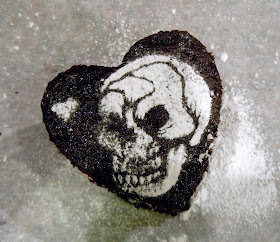Chocolate Peppermint Cream Heart Cakes
Zucchini Chocolate Cake
2 cups flour
2 cups sugar
1/2 cup unsweetened cocoa
1 tsp baking powder
1 tsp baking soda
1/2 tsp salt
3 cups shredded zucchini
1 cup semisweet chocolate baking chips
1 cup salad oil
4 large eggs
In a large bowl, mix flour, sugar, cocoa, baking powder,
baking soda, and salt. Stir in zucchini, and chocolate chips. In a
small bowl, beat oil to mix with eggs; add to dry mixture and stir to moisten
well.
Line two large jelly roll pans with parchment paper, crease corners to fit and spread half the batter in each pan. Bake in a 325° oven until a toothpick inserted in center comes out clean, 15-20 minutes.
While cake is cooling make peppermint cream filling.
Peppermint Cream
2 sticks (1 cup) unsalted butter, softened
1 cup granulated sugar
1 cup whole milk
1/4 cup sifted all-purpose flour
1 teaspoons vanilla extract
1 1/2 teaspoon peppermint extract
red food coloring
Cream the butter with a mixer on medium speed until soft about 30 seconds. Add the sugar and beat on high speed until light and fluffy, 5 to 7 minutes.
In a small saucepan, combine 1/4 cup of the milk, the flour, and the vanilla extract, and whisk until there are no lumps. Over medium heat, slowly add the remaining 3/4 cup milk, whisking constantly, and cook until the mixture comes to a low boil. Then reduce the heat to low and keep whisking for a few more minutes, until the mixture starts to thicken.
Immediately remove the pan from the heat, but keep stirring and cool to room temperature. If necessary, place the pan over a bowl of ice water to stop the cooking process and allow the mixture to cool.
With the mixer on low speed, slowly pour the milk mixture into the butter-sugar mixture. Increase the speed to medium and beat until the frosting is light and fluffy, 3 to 5 minutes. Add peppermint to combine.
After cake has cooled use a heart shaped cookie cutter and cut out cake hearts and place on a clean piece of parchment. One pan had thicker hearts so I made those the bottoms and the thinner hearts the tops.
Place peppermint cream in a large ziplock bag, snip corner and squeeze out cream onto half the hearts and place a second heart on top.
Now you could stop here or you could keep going by cutting some heart stencils and and dusting the hearts with powdered sugar.
 |
| What can I say, Indigo and I were doing this together, lol |
Indigo perfected the dusting process by finding if you brush the remaining powder sugar off the stencil before lifting it you get a cleaner design.
Here's some of the stencils we made
Enjoy!
Check out all these
LOVE infused tutorials
Jane LaFazio's Sketchbook page to Valentine Card (& envelope too)
Traci Bunkers, Printed Heart Ice Cube Trays: Quick Printed Backgrounds, Part 1
Diana Trout's, Woven Heart Valentines Card
Lyric Kinard's, Lovin' my Thermofax Screens
Judy Coates Perez Chocolate Peppermint Cream Heart Cakes
Melanie Testa, Tuesday, Jan 31



 After the quilting was finished, I marked out the finished size: 24" x 60", sewed a tight straight stitch just inside the marked line, then trimmed it to size.
After the quilting was finished, I marked out the finished size: 24" x 60", sewed a tight straight stitch just inside the marked line, then trimmed it to size.